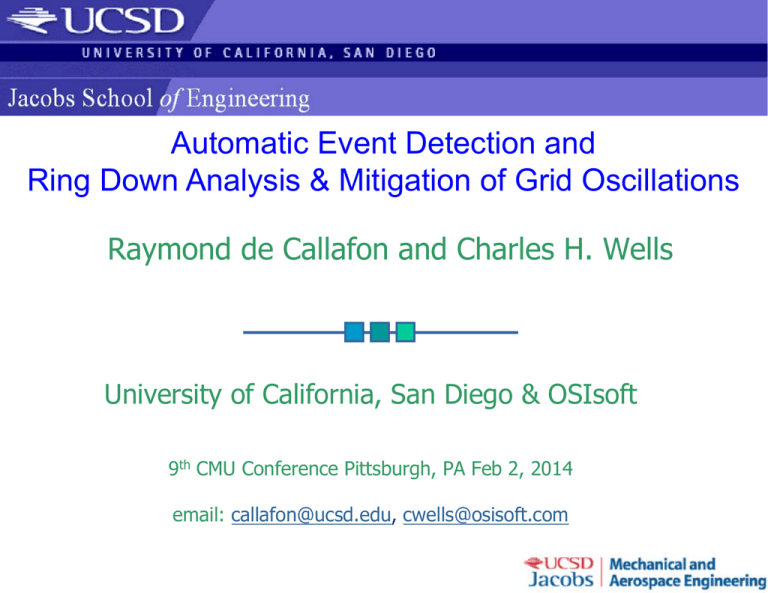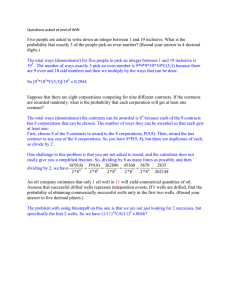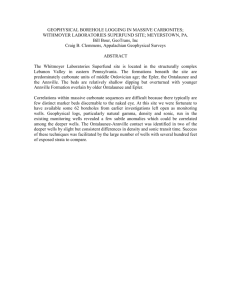Automatic Event Detection and Raymond de Callafon and Charles H. Wells
advertisement

Automatic Event Detection and Ring Down Analysis & Mitigation of Grid Oscillations Raymond de Callafon and Charles H. Wells University of California, San Diego & OSIsoft 9th CMU Conference Pittsburgh, PA Feb 2, 2014 email: callafon@ucsd.edu, cwells@osisoft.com UCSD Phasor Measurement System 2 , Callafon & Wells Additional PMUs 3 microPMUs from PSL (ARPA-E funded) Callafon & Wells Goals Identification/classification: Identify major modes of grid oscillation Identify their frequencies, damping and modal participation Develop dynamic model that can be used for future control/mitigation of disturbances Analysis/control: 4 Determine how well models correlate with modes Use models for automatic control for mitigation Callafon & Wells Our main contributions Detection of Events via Filtered Rate of Change (FRoC) signal Ring Down Analysis of Events via Realization Algorithm Use dynamic model from Realization Algorithm Design low-order real-time (automatic) control with minimal control effort Illustration in this talk: 5 Discrete-Time State Space Modeling of disturbance data. Modeling of grid real power dynamics Mitigation of Events via Real-time Control Auto Regressive Moving Average (ARMA) filter of ambient data. Definition of Filtered Rate-of-Change (Froc) signal for Event Detection Part 1: Automatic event detection applied to May 30 WECC event Part 2: UCSD Microgrid: analysis and control of Oct. 9 event Callafon & Wells PART 1 PART 1 Automatic Event Detection Application to May 30 WECC disturbance 6 Callafon & Wells Illustration on May 30th WECC data Grid events/oscillations (example: May 30 WECC event) PMU generated frequency signal How do we detect individual events? How can we quantify these events? What do these events tell us about our (micro)grid? May 30 data: 972000 data points (30Hz sampling noon-9pm) 7 Callafon & Wells FRoC Signal - ARMA filter In ambient situation we may assume: Fluctuations in frequency signal assumed due to “random noise” on grid can be modeled as a “filtered white noise” where is an unknown filter and Possible approximation for filter , 8 : ARMA filter 1 Filter is stable and stably invertible We can compute , is a white noise. ⋯ ⋯ , , , ⋯ ⋯ Parameters can be estimated via Least Squares (Prediction Error) to minimize variance of error , . Callafon & Wells FRoC Signal – RoC filter we have “smallest possible” , , during ambient behavior. To create FRoC: add additional filtering on , to monitor Rate of Change in Typical Filter: , 1 0.1367 0.1367 , 0.9 0.7265 END RESULT: a real-time recursive formula to compute : With optimal value of 1 1 9 Callafon & Wells ⋯ ⋯ FRoC Signal – RoC filter In our case based on real-time PMU data we created the discretetime filter equation to obtain FRoC(k): 0.12786 ∙ 0.25411 ∙ 3.48506 ∙ 2.61982 ∙ 0.25412 ∙ 1 3 0.12694 ∙ 1 4.54036 ∙ 3 0.56464 ∙ Compared with ROCOF(k): 30 (dirty discrete-time derivative) 10 0.00094 ∙ 4 2 4 Callafon & Wells 1 2 FRoC Signal – RoC filter Bode plot of filters used to create FRoC(k) and ROCOF(k) illustrates the benefits: 11 Filter looks like a ‘differentiator’ Additional filtering of harmonic disturbances ambient data at 0.35Hz Additional low pass filter to reduce noise Callafon & Wells FRoC Signal – what’s the big deal? 12 Small during ambient behavior Even for “noisy” NI PMU Callafon & Wells FRoC Signal – what’s the big deal? Compare with ROCOF: 1 ∆ (dirty discrete-time derivative) 13 Much larger than Would require larger thresholds FRoC(k) Callafon & Wells FRoC Signal – what’s the big deal? Small thresholds with small during ambient behavior Detection of events via: Set threshold based on ambient data outside threshold for m consecutive points 14 Classify event by saving/analyzing N data points Callafon & Wells FRoC Signal – what’s the big deal? Compare with ROCOF Much larger than FRoC(k) 15 More false alarms Callafon & Wells Automatic Detection Results Automatically: 16 Detect event. (via threshold on Filtered Rate of Change signal) Callafon & Wells Automatic Detection Results Automatically: Detect event. (via threshold on Filtered Rate of Change signal) Able to distinguish 14 separate events over 9 hour data 17 Callafon & Wells FRoC Signal – application to May 30 data 18 Callafon & Wells FRoC Signal – application to May 30 data Event 4.1 19 Callafon & Wells FRoC Signal – application to May 30 data Event 4.3 20 Callafon & Wells FRoC Signal – application to May 30 data 21 Callafon & Wells FRoC Signal – application to May 30 data 22 Callafon & Wells PART 2 PART2 UCSD Microgrid Ring Down Analysis of Oct. 9 event Mitigation of events via real-time control 23 Callafon & Wells Analysis of Events - Realization Algorithm detect beginning of event x(t 1) Ax(t ) Bd (t ) F (t ) Cx(t ) 24 Callafon & Wells analysis Analysis of Events - Realization Algorithm Approach: Assume observed event in frequency F(t) is due to a deterministic system x(k 1) Ax(k ) Bd (k ) F (k ) Cx(k ) Discrete-time model where (unknown) input d(t) can be `impulse’ or `step’ or `known shape’ Store a finite number of data points of F(t) in a special data matrix H Inspect rank of (null projection on) H: determines # modes Excellent results from lab experiments Compute matrices A, B and C via Realization Algorithm. Extension of Ho-Kalman, Kung algorithm. Miller, de Callafon (2010) Applicable to multiple time-synchronized measurements! (multiple PMUs) End Result: Dynamic model (state space model) can be used for 25 Simulation: simulate the disturbance data Analysis: Compute resonance modes and damping (from eigenvalues of A) Callafon & Wells Oct. 9 UCSD microgrid event Measurements from SEL breaker at 12kV 3 phase line (6.9kV phase to phase) RMS Voltage and Current of 3 phases Real Power Apparent Power Disturbance on 3 phase network 26 Callafon & Wells Oct. 9 UCSD microgrid event Measurements from SEL breaker at 12kV 3 phase line (6.9kV phase to phase) 27 RMS Voltage and Current of 3 phases Real Power Apparent Power Callafon & Wells Oct. 9 UCSD microgrid event Main conclusions from Measurements from SEL breaker: Sustained oscillations in 3 phase V and I mostly due to reactive power. Real power oscillations dampen out faster (time adjusted) Frequency show similar dynamics as Real Power: 28 Callafon & Wells Analysis of UCSD microgrid dynamics Realization Algorithm: excellent fit of oscillation/damping Modeled frequencies Fn, damping D and model participation P: Mode around 1.4Hz less than 5% damping, 85% participation 29 Callafon & Wells Analysis of UCSD microgrid dynamics Dynamic model found by realization in Bode plot (frequency domain) Observe large resonance frequency around 1.4Hz MITIGATION Control/damping of 1.4Hz oscillation 30 Callafon & Wells Mitigation of UCSD microgrid dynamics MITIGATION Control/damping of 1.4Hz oscillation via Real Power control: disturbance Identified model G(z) Network control power 31 Relay/PMU Control Algorithm C(z) real power What is the control algorithm? How much control power is needed to dampen oscillation? Callafon & Wells Mitigation of UCSD microgrid dynamics Identified Discrete-Time Model G(z): 0.2791 ^6 1.677 ^5 4.204 ^4 5.63 ^3 4.249 ^2 1.713 0.2882 ^7 6.89 ^6 20.39 ^5 33.58 ^4 33.26 ^3 19.8 ^2 6.564 0.9344 Proposed control algorithm C(z) that has the following shape: 1 32 Discrete-time differentiator (to add damping + reduce low frequency control) Two poles (a,b) to limit bandwidth Gain K to adjust power gain Callafon & Wells Mitigation of UCSD microgrid dynamics Choice of control parameters K, and b in 1 via loop shaping tool Shape Bode plot of L(z)=G(z)C(z) See direct effect of: Damping Stability Control signal 33 Callafon & Wells Mitigation of UCSD microgrid dynamics End result of control design: 1 , 0.085211, 0.9757, 0.7933 Resulting discrete control algorithm: 0.0852 ∙ 0.7740 ∙ 1 0.0852 ∙ Identified model G(z) Network control power u(k) Callafon & Wells 1.7690 ∙ 2 disturbance 34 2 Relay/PMU C(z) real power P(k) 1 Mitigation of UCSD microgrid dynamics Effect of Control Algorithm: Damping of UCSD microgrid: Damping of controlled UCSD microgrid: Slight change in resonance modes, ten-fold increase in damping! 35 Callafon & Wells Mitigation of UCSD microgrid dynamics Effect of Control Algorithm: 36 Disturbance effect still present (unavoidable) Control algorithm does mitigate disturbance faster! Less oscillations in microgrid (better damping) How much control power needed? Callafon & Wells Mitigation of UCSD microgrid dynamics Effect of Control Algorithm: For comparison, control power plotted at same scale a disturbance in real power 37 Disturbance almost +/- 2MW Control power only +/- 0.25MW for mitigation Results scale with size of disturbance and increase of damping Callafon & Wells Mitigation of UCSD microgrid dynamics Reducing control effort to +/- 125KW still works, but: 38 Damping cannot be influenced that much Still acceptable to improve dynamics of microgrid Control power only +/- 125KW for mitigation Callafon & Wells Summary on Detection and Analysis Automatically detect when a disturbance/transient event occurs Automatically estimate Frequency, Damping and Dynamic Model. Main Features: Automatically detect event: Automatically estimate: 39 Predict ambient Frequency signal “one-sample” ahead Observe when prediction deviates for event detection via FRoC signal # of modes of oscillations in measured disturbance Estimate frequency and damping of the modes Put results in dynamic mode All done in real-time! Note: resulting dynamic model can be used for feedback control design to mitigate event! Callafon & Wells 40 Thank you CMU Meeting, Callafon & Wells








